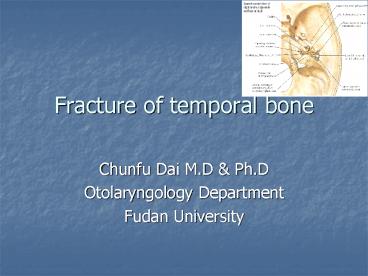Fracture of temporal bone PowerPoint PPT Presentation
1 / 31
Title: Fracture of temporal bone
1
Fracture of temporal bone
- Chunfu Dai M.D Ph.D
- Otolaryngology Department
- Fudan University
2
Classifications
- Longitudinal fractures
- Transverse fractures
- Mixed fractures
3
Longitudinal fractures
- 80 of Temporal Bone Fractures
- Lateral Forces along the petrosquamous suture
line - 15-20 Facial Nerve involvement
- EAC laceration
4
Transverse fractures
- 20 of Temporal Bone Fractures
- Forces in the Antero-Posterior direction
- Inner ear injury
- 50 Facial Nerve Involvement
- EAC intact
5
Physical Examination
- Tuning Fork exam
- Pneumatic Otoscopy
6
Imaging
- HRCT
- MRI
- Angiography/ MRA
7
symptoms
- Hearing Loss tinnitus
- Dizziness
- CSF Otorrhea and Rhinorrhea
- Facial Nerve Injuries
8
Hearing loss
- Formal Audiometry vs. Tuning Fork
- 71 of patients with Temporal Bone Trauma have
hearing loss - TM Perforations
- CHL gt 40db suspicion for ossicular discontinuity
9
Hearing loss
- Longitudinal Fractures
- Conductive or mixed hearing loss
- 80 of CHL resolve spontaneously
- Transverse Fractures
- Sensorineural hearing loss
- Less likely to improve
10
Dizziness
- Otic capsule fracture, labyrinthine concussion,
Perilymphatic Fistula - Perilymphatic Fistulas
- Fluctuating dizziness and/or hearing loss
- Tulios Phenomenon
- Management
- 40 spontaneously close
- Surgical management
11
Dizziness
- BPPV
- Acute, latent, and fatigable vertigo
- Can occur any time following injury
- Dix Hallpike
- Epley Maneuver
12
CSF Otorrhea and Rhinorrhea
- Temporal bone Fractures are the most common cause
of CSF Otorrhea - Beta-2-transferrin
- HRCT
13
CSF Otorrhea and Rhinorrhea
- Management
- Conservative therapy
- Lie in bed with Head elevated 30-45
- Antibiotics
- Surgery
14
CSF Otorrhea and RhinorrheaSurgical Management
- Surgical approach
- Status of hearing
- Meningocele/encephalocele
- Fistula location
- Transmastoid
- Middle Cranial Fossa
15
Facial Nerve Injuries
- Evaluation
- Previous status
- Time
- Onset and progression
- Complete vs. Incomplete
16
House Brackman grading system
- I Normal Normal facial function
- II Mild Slight synkinesis/weakness
- IIIModerate Complete eye closure, noticeable
synkinesis, slight forehead movement - IVModerately Severe Incomplete eye closure,
symmetry at rest, no forehead movement - V Severe Assymetry at rest, barely noticeable
motion - VITotal No movement
17
Electrophysiologic Testing
- NET
- MST
- ENoG
18
Nerve Excitability TestMaximal Stimulation Test
- gt3.5mA difference suggests a poor prognosis for
return of facial function
19
Electroneuronography
- Most accurate, qualitative measurement
- Reduction of gt90 amplitude correlates with a
poor prognosis for spontaneous recovery
20
Electromyography
- Limited use until 10-14 days
- Polyphasic potentials Good
21
Facial Nerve Injuries
- Decision to treat is primarily based on whether
there is complete vs. incomplete paralysis
22
Treatment
- Conservative treatment candidates
- Surgical candidates
23
Conservative Treatment Candidates
- Chang and Cass
- Normal Facial Function regardless of progression
- Incomplete paralysis and no progression to
complete paralysis - Less than 95 degeneration by ENoG
24
Surgical Candidates
- Critical Prognostic factors
- Immediate vs. Delayed
- Complete vs. Incomplete paralysis
- ENoG criteria
25
Algorithm for Facial Nerve Injury
26
Surgical Approach
- Suspect location of neural injury
- Presence or absence of hearing
27
Surgical Approach
- Lateral to the geniculate ganglion
- transmastoid
- Medial to the Geniculate Ganglion
- No useful hearing
- Transmastoid-translabyrinthine
- Intact hearing
- Transmastoid-trans-epitympanic
- Middle Cranial Fossa
28
Surgical findings
- Nerve repair
- Direct anastomosis
- Nerve graft
- Decompression
29
Case Report
- 32 yr old fisherman was wading
- Minding his own business
- Hit in head by a flying fish
- Immediate profound vertigo, hearing loss
- CT scan revealed longitudinal Temp bone fracture
30
(No Transcript)
31
(No Transcript)

